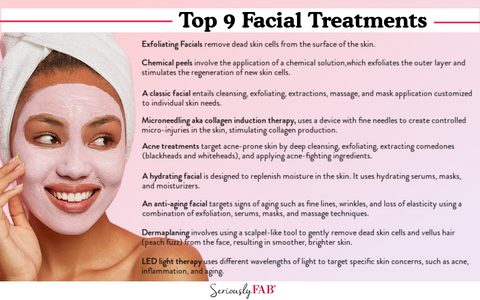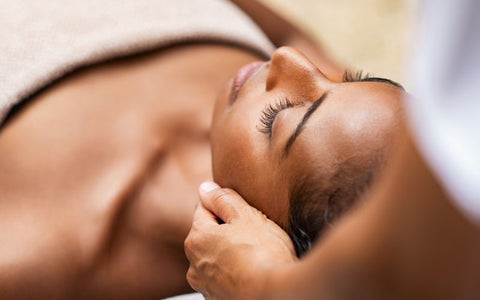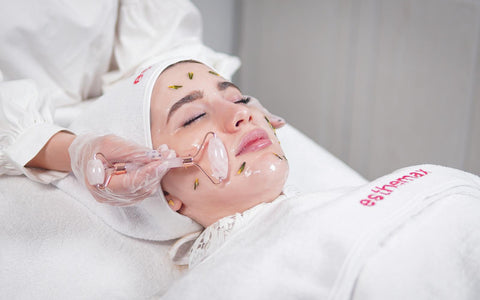
For many, embarking on a journey to healthier, more radiant skin may involve certain facial treatments. This could include exfoliating, chemical peels, facials, microneedling, and more. These popular treatments can work wonders for your skin, however, they also leave your skin sensitive to sun damage. If you're wondering if it's safe to use sunscreen after a facial treatment, stick around. In this guide, we'll detail nine types of facial treatments, why sunscreen is essential post treatment, how long to wait before sunscreen application, and tackle any safety concerns.
Top 9 Types of Facial Treatments
Exfoliating Facial
An exfoliating facial involves the removal of dead skin cells from the surface of the skin using physical or chemical exfoliants. Improves skin texture, unclogs pores, reduces the appearance of fine lines and wrinkles, and enhances the absorption of skincare products. In terms of risks, just be aware that over-exfoliation can lead to irritation, redness, and sensitivity, especially for those with sensitive skin.
Chemical Peel
A chemical peel involves the application of a chemical solution to the skin, which exfoliates the outer layer and stimulates the regeneration of new skin cells. Addresses concerns such as hyperpigmentation, acne scars, fine lines, and uneven skin tone. Chemical peels can cause temporary redness, peeling, and sensitivity. In rare cases, chemical peels can lead to scarring or changes in skin pigmentation, especially with deeper peels.
Classic Facial
A classic facial involves cleansing, exfoliating, extractions, massage, and mask application customized to individual skin needs. Cleanses pores, improves circulation, promotes relaxation, and nourishes the skin. Risks are very minimal, although improper extraction techniques can lead to skin irritation or breakouts.
Microneedling
Microneedling, also known as collagen induction therapy, involves using a device with fine needles to create controlled micro-injuries in the skin, stimulating collagen production. Reduces fine lines and wrinkles, improves skin texture, minimizes pore size, and enhances the absorption of skincare products. Possible side effects include temporary redness, swelling, and mild discomfort. In rare cases, infection or scarring may occur if proper sterilization procedures are not followed.

Acne Treatment Facial
An acne treatment facial targets acne-prone skin by deep cleansing, exfoliating, extracting comedones (blackheads and whiteheads), and applying acne-fighting ingredients. Helps clear existing acne, prevents future breakouts, reduces inflammation, and promotes healing. Potential for irritation or sensitivity, especially with harsh acne-fighting ingredients. Improper extraction techniques can lead to scarring or infection.
Hydrating Facial
A hydrating facial is designed to replenish moisture in the skin. It uses hydrating serums, masks, and moisturizers. Restores hydration levels, improves skin elasticity, reduces dryness and flakiness, and gives the skin a radiant glow. Minimal risks, although individuals with very oily skin may find some hydrating products too heavy.
Anti-Aging Facial
An anti-aging facial targets signs of aging such as fine lines, wrinkles, and loss of elasticity using a combination of exfoliation, serums, masks, and massage techniques. Stimulates collagen production, firms and tones the skin, reduces the appearance of wrinkles, and promotes a youthful complexion. Minimal risks, although individuals with sensitive skin may experience redness or irritation from active anti-aging ingredients.
LED Light Therapy Facial
LED light therapy involves exposing the skin to different wavelengths of light to target specific skin concerns, such as acne, inflammation, and aging. Reduces acne-causing bacteria, calms inflammation, stimulates collagen production, and improves overall skin tone and texture. Minimal risks, although individuals with light-sensitive conditions or certain medications may need to avoid specific wavelengths of light.
Dermaplaning
Dermaplaning involves using a scalpel-like tool to gently remove dead skin cells and vellus hair (peach fuzz) from the face, resulting in smoother, brighter skin. It can improve the effectiveness of skincare products and makeup application. Risks include minor irritation, redness, or sensitivity, particularly if the procedure is performed too aggressively. There's also a slight risk of infection if proper sanitation protocols aren't followed.

Is it Safe to Use Sunscreen After Facial Treatments?
Absolutely. Sunscreen is not only safe but also essential after facial treatments. However, it's crucial to choose a sunscreen that's suitable for your skin type and any sensitivities you may have. Look for products labeled broad-spectrum and opt for non-comedogenic formulas if you're prone to breakouts. Fragrance-free options can also minimize the risk of irritation, especially after treatments that may have temporarily compromised your skin barrier.
How Long to Wait Before Applying Sunscreen
Timing is everything when it comes to applying sunscreen after facial treatments. Dermatologists typically recommend waiting at least 15 to 20 minutes after your treatment before applying sunscreen. This allows your skin to settle and recover from the treatment while ensuring that the sunscreen won't interfere with its efficacy. Waiting also gives any post-treatment products you've applied a chance to fully absorb into your skin before you seal everything in with sunscreen.

The Importance of Sunscreen After Facial Treatments
Many facial treatments can leave your skin more sensitive and prone to sun damage. Here's why sunscreen is non-negotiable post-treatment:
Increased Sensitivity: These treatments often remove the outer layer of dead skin cells, leaving your fresh, new skin more susceptible to UV radiation. Without proper protection, sun exposure can lead to sunburn, premature aging, and even skin cancer.
Preserving Treatment Results: Exposing your newly treated skin to the sun can diminish the effectiveness of your facial treatments. Sun damage can undo the progress you've made, whether it's fading dark spots, improving texture, or clearing acne. By wearing sunscreen religiously, you can safeguard your investment in your skin and prolong the results of your treatments.
Long-Term Skin Health: Consistent sunscreen use isn't just about protecting your skin in the short term – it's an investment in your long-term skin health. By minimizing sun damage, you can maintain a youthful complexion, prevent wrinkles and fine lines, and reduce your risk of developing skin cancer.
Sunscreen isn't just an afterthought – it's a crucial step in protecting your skin after facial treatments. It's not called your skin's BFF for nothing! Additionally, be sure to consult with a qualified skincare professional before undergoing any facial treatment. They can help determine the best approach for your specific skin concerns and to minimize the risk of adverse reactions. Cheers to the journey to healthy, radiant skin!

